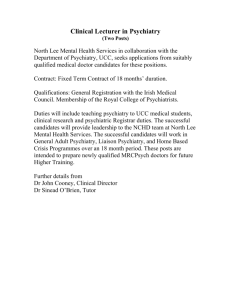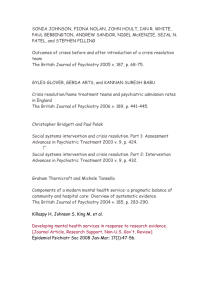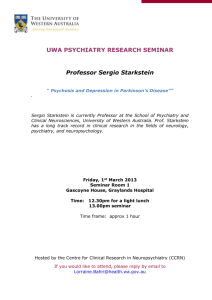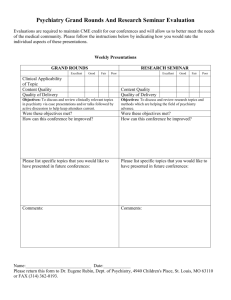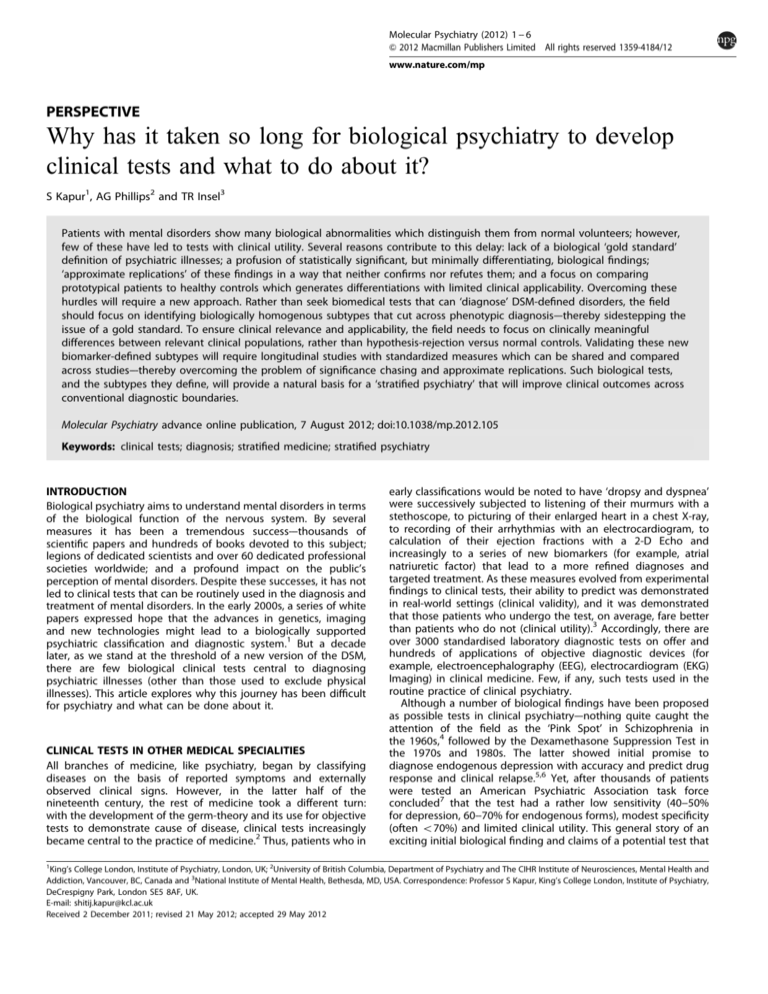
Molecular Psychiatry (2012) 1 -- 6
& 2012 Macmillan Publishers Limited All rights reserved 1359-4184/12
www.nature.com/mp
PERSPECTIVE
Why has it taken so long for biological psychiatry to develop
clinical tests and what to do about it?
S Kapur1, AG Phillips2 and TR Insel3
Patients with mental disorders show many biological abnormalities which distinguish them from normal volunteers; however,
few of these have led to tests with clinical utility. Several reasons contribute to this delay: lack of a biological ‘gold standard’
definition of psychiatric illnesses; a profusion of statistically significant, but minimally differentiating, biological findings;
‘approximate replications’ of these findings in a way that neither confirms nor refutes them; and a focus on comparing
prototypical patients to healthy controls which generates differentiations with limited clinical applicability. Overcoming these
hurdles will require a new approach. Rather than seek biomedical tests that can ‘diagnose’ DSM-defined disorders, the field
should focus on identifying biologically homogenous subtypes that cut across phenotypic diagnosis---thereby sidestepping the
issue of a gold standard. To ensure clinical relevance and applicability, the field needs to focus on clinically meaningful
differences between relevant clinical populations, rather than hypothesis-rejection versus normal controls. Validating these new
biomarker-defined subtypes will require longitudinal studies with standardized measures which can be shared and compared
across studies---thereby overcoming the problem of significance chasing and approximate replications. Such biological tests,
and the subtypes they define, will provide a natural basis for a ‘stratified psychiatry’ that will improve clinical outcomes across
conventional diagnostic boundaries.
Molecular Psychiatry advance online publication, 7 August 2012; doi:10.1038/mp.2012.105
Keywords: clinical tests; diagnosis; stratified medicine; stratified psychiatry
INTRODUCTION
Biological psychiatry aims to understand mental disorders in terms
of the biological function of the nervous system. By several
measures it has been a tremendous success---thousands of
scientific papers and hundreds of books devoted to this subject;
legions of dedicated scientists and over 60 dedicated professional
societies worldwide; and a profound impact on the public’s
perception of mental disorders. Despite these successes, it has not
led to clinical tests that can be routinely used in the diagnosis and
treatment of mental disorders. In the early 2000s, a series of white
papers expressed hope that the advances in genetics, imaging
and new technologies might lead to a biologically supported
psychiatric classification and diagnostic system.1 But a decade
later, as we stand at the threshold of a new version of the DSM,
there are few biological clinical tests central to diagnosing
psychiatric illnesses (other than those used to exclude physical
illnesses). This article explores why this journey has been difficult
for psychiatry and what can be done about it.
CLINICAL TESTS IN OTHER MEDICAL SPECIALITIES
All branches of medicine, like psychiatry, began by classifying
diseases on the basis of reported symptoms and externally
observed clinical signs. However, in the latter half of the
nineteenth century, the rest of medicine took a different turn:
with the development of the germ-theory and its use for objective
tests to demonstrate cause of disease, clinical tests increasingly
became central to the practice of medicine.2 Thus, patients who in
early classifications would be noted to have ‘dropsy and dyspnea’
were successively subjected to listening of their murmurs with a
stethoscope, to picturing of their enlarged heart in a chest X-ray,
to recording of their arrhythmias with an electrocardiogram, to
calculation of their ejection fractions with a 2-D Echo and
increasingly to a series of new biomarkers (for example, atrial
natriuretic factor) that lead to a more refined diagnoses and
targeted treatment. As these measures evolved from experimental
findings to clinical tests, their ability to predict was demonstrated
in real-world settings (clinical validity), and it was demonstrated
that those patients who undergo the test, on average, fare better
than patients who do not (clinical utility).3 Accordingly, there are
over 3000 standardised laboratory diagnostic tests on offer and
hundreds of applications of objective diagnostic devices (for
example, electroencephalography (EEG), electrocardiogram (EKG)
Imaging) in clinical medicine. Few, if any, such tests used in the
routine practice of clinical psychiatry.
Although a number of biological findings have been proposed
as possible tests in clinical psychiatry---nothing quite caught the
attention of the field as the ‘Pink Spot’ in Schizophrenia in
the 1960s,4 followed by the Dexamethasone Suppression Test in
the 1970s and 1980s. The latter showed initial promise to
diagnose endogenous depression with accuracy and predict drug
response and clinical relapse.5,6 Yet, after thousands of patients
were tested an American Psychiatric Association task force
concluded7 that the test had a rather low sensitivity (40--50%
for depression, 60--70% for endogenous forms), modest specificity
(often o70%) and limited clinical utility. This general story of an
exciting initial biological finding and claims of a potential test that
1
King’s College London, Institute of Psychiatry, London, UK; 2University of British Columbia, Department of Psychiatry and The CIHR Institute of Neurosciences, Mental Health and
Addiction, Vancouver, BC, Canada and 3National Institute of Mental Health, Bethesda, MD, USA. Correspondence: Professor S Kapur, King’s College London, Institute of Psychiatry,
DeCrespigny Park, London SE5 8AF, UK.
E-mail: shitij.kapur@kcl.ac.uk
Received 2 December 2011; revised 21 May 2012; accepted 29 May 2012
Clinical tests and biological psychiatry
S Kapur et al
2
subsequently wanes due to limited accuracy or generalizability in
real-life clinical settings has been repeated many times.8,9 The lack
of clinical tests is striking given that biological psychiatry has been
very productive in generating new scientific findings: a corpus of
over 107 000 articles already available on PubMed with over a 100
new articles being added to this every single week. Why then has
it been so difficult to convert biological findings into clinical tests
for use in psychiatry?
THE MISSING GOLD STANDARD
To create a biological test to assist in the diagnosis of an illness
one needs a stable and biologically valid concept of the illness.
Although the International Classification systems for physical
illnesses began in 1900, the first efforts to formulate a
comprehensive diagnostic scheme in psychiatry did not occur
until the 1950s when the International Classification of Diseases-6
(ICD-6) first addressed a chapter dedicated to mental disorders
and the first version of the Diagnostic and Statistical Manual of
mental disorders, the DSM-I arrived. It was not until the 1970s that
serious efforts were made to operationalise the early vignettes
into standardised diagnostic criteria and although Guze and
Robins10 anticipated the critical role that laboratory tests might
have, they lamented the absence of any such viable tests at that
time. In the 1990s, two decades later, when the expected
laboratory tests had not arrived, Andreasen11 called for ‘new
models and new approaches’ to diagnostic validation based on
genetics and imaging. In the early 2000s, as the stage was being
set for the Research Agenda for DSM-V,1 a similar hope was
expressed again---although the promise is yet to be realised a
decade later.
As the standardised classification systems have been constantly
revised (from ICD-6 to ICD-10 and from DSM-I to DSM-IV), they
have remained a descriptive taxonomy based on expressed
feelings and observed behaviour. On the one hand, these
successive editions of DSM and ICD lead to increasing psychometric precision. On the other hand, the ever increasing
fractionation of mental distress into smaller and more numerous
categories, without a priori biological validity, makes it harder to
find specific biomedical tests that diagnose or predict the disorders. The search for specific clinical tests is further complicated by
extensive comorbidity across these disorders is rather common.
Psychiatric disorders tend to breed across categories almost as
frequently as within12 and their genetic predispositions defy the
conventional diagnostic boundaries. Furthermore, the very concept of ‘categorical’ psychiatric disorders is questioned by some
who suggest that a dimensional spectrum may provide a better
account of the clinical reality.13,14 Even if one acknowledges the
primacy of biological factors in some psychiatric disorders, it does
not inevitably follow that a biological test would be necessarily
most informative or effective in identifying them. Kendler15 argue
that genes and molecules have to work via dozens of ‘mechanistic
levels’ (for example, molecules are embedded in membranes,
which form neurons, which form ensembles, which fire in a certain
order and so on), therefore the likelihood that a biological
alteration will have a powerful one-to-one mapping with a DSMdefined mental disorder may be unlikely.
Thus, psychiatry seems to be in a Catch-22: the current diagnostic system was not designed to facilitate biological differentiation and it does not. The biological studies to date have not
been able to propose a clinically viable alternative system.
This lack of a gold standard, and the consequent circularity, is
not unique to psychiatry. A number of disorders in physical
medicine defy simple biological definitions. Breast lumps were
categorised based on different symptoms and clinical courses,
until histopathological differentiation and molecular markers
turned them into distinct illnesses. Arthritides were classified by
Molecular Psychiatry (2012), 1 -- 6
symptoms, signs and illness course until immune markers and
imaging findings differentiated them into different biologically
valid illnesses. If one does not have a priori gold standards one can
still make progress provided one has biological findings with large
effect sizes that correlate with outcomes of a psychiatric disorder.
And this has been a challenge for biological psychiatry.
SIGNIFICANCE CHASING WITH UNDERPOWERED STUDIES
The vast majority of biological findings in psychiatry are of a small
or moderate effect size---even though many of them survive the
‘Po0.05’ test of statistical significance. Ioannidis has demonstrated
that most initial reports of statistically significant but small-effect
findings are never substantiated16 and the ones that are often
have even lower effects than initially apparent.17 Given that efforts
to replicate an initial finding usually involve a different clinical
setting, a different patient selection and slightly different methods--the chance of replication after an original finding with a Po0.05 is
often o50%.18,19 Although these risks are not unique to biological
psychiatry, it is particularly vulnerable to ‘significance chasing’
because the studies in this field generally tend to be underpowered, have small sample sizes,20,21 measure multiple dimensions and use subjective outcomes.22
This challenge of identifying reliable findings on which to base a
clinical test strategy is highlighted by two examples: from a
handful of articles in the 1970s, there are now over 12 000 articles
on ‘schizophrenia genetics’, with much of this expansion coming
in the last decade. The dizzying array of genetic associations
is compiled in the SZGene database with over 1700 studies of
1000 genes and 8000 polymorphisms leading to hundreds of
‘statistically significant’ associations. Collins et al.23 systematically
compared some 732 genes implicated in 1374 of these studies,
and found that most of these ‘findings’ were contained in only
one study and were never followed up systematically, and the vast
majority of these initially positive findings have failed to replicate
in subsequent large-scale genome wide analyses.23 A similar
pattern emerges in schizophrenia and imaging---Davidson and
Heinrich24 evaluated over two decades of imaging studies in
schizophrenia and identified 25 distinct measures amenable to a
meta-analysis and found that the majority of these were inconsistent, with more prominent findings associated with greater
inter-study inconsistency.24,25 This variation is by no means unique
to schizophrenia, or genetics or imaging, or even to psychiatry.
However, chasing small effects with underpowered studies has
meant that even though the field has led to a large output of
publications, there are few findings with effect-sizes large enough
that could be converted into clinical tests.
APPROXIMATE REPLICATIONS
One might expect that failure to replicate the findings would
induce scientists to lose interest in the given area and to move on
to findings with more robust effects.26 Unfortunately, an initial
underpowered study is often followed by another study of similar
size but with a few additional measures and variables to give it
some novelty and distinction. These subsequent studies usually
have only modest statistical power to decisively confirm or refute
the original finding, but do have sufficient multiplicity of new
measures to generate some significant finding---even though not
precisely the one observed in the first study---thus providing an
‘approximate replication’.26 As a result, the ‘literature’ in the
field grows without decisively replicating/rejecting the precise
original finding, but instead creates a penumbra of ‘Po0.05’
findings around the first. This problem is well illustrated by the
many studies examining frontal dysfunction in schizophrenia.
Since the first reports (1998) that ‘working memory deficits’ are
associated with ‘frontal dysfunction’ in schizophrenia, over 30
studies including 750 individuals have examined this question.27
& 2012 Macmillan Publishers Limited
Clinical tests and biological psychiatry
S Kapur et al
These studies have used two different imaging technologies, four
distinct working memory paradigms and three different modalities (visual, verbal, mixed), with some studies providing a
reward, others not, with an average size of a mere 12 subjects. Not
surprisingly then, a dozen of these findings show that patients are
hyperfrontal as compared with healthy controls, nearly as many
show that patients are hypofrontal, whereas a few studies show
no discernable difference. There may well be interesting scientific
reasons for these opposing findings, perhaps a mediating variable
that is yet to be identified, but, until such variation is explained,
controlled and removed from such findings, these approximate
replications do not provide a reliable basis for clinical tests.
EXTREME COMPARISONS
Nonetheless, some biological findings have stood the test of time
and replication, and have reasonably large effect sizes: patients
with schizophrenia have larger ventricles and smaller gray matter,
their electrophysiological evoked responses are reliably diminished and both pre-pulse inhibition and latent inhibition are
impaired.21,25 However, these large differences have been noted
mostly in studies comparing prototypical patients versus pictureperfect healthy controls. Clinically, one is rarely taxed with distinguishing a textbook patient from a perfectly healthy individual.
The real challenge is in distinguishing those who demonstrate the
superficially similar symptoms that may merit rather different
treatments and outcomes: distinguishing between someone
with bipolar depression from unipolar depression, distinguishing
someone with severe obsessions with a firm conviction in them
from someone with delusions focussed around repetitive behaviors. Experience in the rest of medicine shows that the predictive
value of a biological differentiator decreases as we move from
extreme contrasts to more clinically relevant ones.28,29 Thus it
remains unclear whether some of the currently prominent
findings would form clinically useful tests, if actually applied to
the challenging clinical circumstances in which these tests would
actually be useful.
WHAT TO DO ABOUT THIS?
Like the rest of medicine, psychiatry often uses biological tests to
exclude other disorders (for example, hypothyroidism in depression, brain tumours in psychosis and so on). But, there are few
tests that are used to confirm a diagnosis or a choice of treatment.
For successful biological tests one needs important basic
biological discoveries. That is a given. But, it is not enough. In
addition to basic advances the field needs to be clear about: the
kind of tests it seeks, relationship of these putative tests to current
diagnostic schemes, standardised ways of collecting and sharing
data, and a search for clinically meaningful differences, rather than
just statistically significant ones.29
WHAT KIND OF ‘TEST’ SHOULD WE LOOK FOR?
Screening tests are used to identify diseases in populations that
are currently asymptomatic: phenylketonuria in newborns, Pap
smears in healthy women. As screening tests are offered to
otherwise healthy people---they require very high specificity, must
lead to substantial clinical gains and require stringent evaluation
of ethical and social implications.30,31 Few biological screening
tests have been developed without a plausible and understandable link to the aetiology or pathophysiology of the
disease---thus biological screening for most psychiatric disorders
seems distant. What seems within reach are behavioral screens for
early identification and screening for discrete genetic alterations
(for example, polymorphisms, copy number variants) associated
with a higher risk for behavioral disorders---the opportunities and
& 2012 Macmillan Publishers Limited
complexities of such genetic tests for screening are debated
elsewhere.32,33
The most commonly used tests in medicine are those that
confirm diagnoses and help choose treatments. The prospects of
‘diagnostic tests’ for DSM entities remain distant for reasons
articulated above, and it seems unlikely that we will replace the
300-disorder taxonomy of the DSM-5 with an alternative
biologically based classification system anytime soon. Therefore
the real opportunity for psychiatry is to use the emerging
advances in genetics, molecular biology, imaging and cognitive
science to supplement, rather than replace, the symptom-driven
diagnosis. It is often like this in the rest of medicine.
There is currently no single physiological, immunological,
histological test for diagnosing asthma---the diagnosis is made
based on the pattern of symptoms and clinical findings. Yet, the
measurement of forced expiratory volume provides an objective
test to determine therapy and monitor the response, and various
immunological tests help identify specific aetiologies.34 Arthritis
itself remains a clinical diagnosis, but the presence or absence of
rheumatoid factor (neither of which is diagnostic or exclusionary
of the primary diagnosis) leads to different forms of intervention.35
Thus, while conventional screening and diagnostic tests seem
distant---more selective tests that ‘subtype’ currently prevalent
mental disorders or predict potentially beneficial or adverse
response to specific drug therapies are within reach.
FROM SUBTYPES TO ‘STRATIFIED MEDICINE’---THE PLAUSIBLE
GOAL FOR PSYCHIATRY
Ever since Langreth and Waldhoz coined the term ‘personalised
medicine’, authors in psychiatry have enthusiastically endorsed
this call---although ‘personalized’ means different things to
different authors.36--38 In fact, there are few examples of truly
‘personalised’ medicine, if by it one means unique intervention
customised just for the given individual (quite like a bespoke
tailored jacket, such that no two fits are alike). Some emerging
patient-personalised vaccines39 or the use of an individual’s own
cells to derive grafts40 are exemplars of truly personalised
medicine. It is hard to envisage large-scale application of this
principle to psychiatry or medicine any time soon. A more feasible
opportunity for psychiatry, as for the rest of medicine, is ‘stratified
medicine’:41 the identification of biomarkers or cognitive tests that
stratify a broad-illness phenotype into a finite number of
treatment-relevant subgroups (keeping with the sartorial analogy
above, a jacket with a series of chest sizes rather than a one-sizefits-all approach used currently).
Progress in oncology illustrates this approach well: overexpression of human epidermal growth factor subtype 2 (HER2) in breast
cancer tissue was first identified as a subtype with a poor
prognosis.42 As the differential biology of this subtype was better
understood, it led to the development of monoclonal antibody
therapies (trastuzumab or Herceptin) which increased long-term
survival for this particular subtype of breast cancer.43 While HER2
was first observed in breast cancer, overexpression of HER2 has
now been observed in subtypes of ovarian, endometrial, nonsmall-cell lung and gastric cancer and the HER2 stratification is
being used to guide treatment in these cancers as well. Several
variants of this ‘stratified’ approach are now making their way to
the clinic: the use of K-ras mutations to stratify colorectal
cancer, thereby identifying patients who would not benefit
from cetuximab; the use of UGT1A1 polymorphisms to identify
subgroups of patients who should avoid irinotecan in its
treatment.44
This approach to ‘stratified medicine’ has several important
lessons for psychiatry: First, it bypasses the nosological debates
about the precise diagnostic boundaries and does not need an
external ‘gold standard’, as the approach justifies itself by its
utility.45 Second, stratification does not require a complete
Molecular Psychiatry (2012), 1 -- 6
3
Clinical tests and biological psychiatry
S Kapur et al
4
understanding of aetiology---it was possible to stratify patients
based on HER2, even though the ultimate aetiology of breast
cancer remains unknown. Third, one does not have to wait for
new treatments to arrive---stratification to predict prognosis
became possible almost a decade before a viable treatment
became available.42 Finally, these tests become useful in clinical
medicine across diagnoses without requiring wholesale diagnostic
reclassification: HER-2 sub-typing is clinically useful in breast,
ovarian, lung and gastric cancer, yet, each of these cancers remain
distinct clinical entities. Thus, in a ‘stratified psychiatry’, these tests
could coexist alongside the conventional diagnostic systems (such
as DSM5 or ICD11). The patients could be first diagnosed along
conventional grounds, but then stratified by markers that predict
prognosis or suggest differential treatments.
The earliest instances of this in psychiatry are already emerging
from pharmacogenomics: of the 119 FDA-approved pharmacogenomic biomarkers, which appear in drug labels, 30 of them
relate to psychiatric drugs.46 Almost all of the psychiatric
biomarkers are variants of CYP2D6 and CYP2C19 drugmetabolising enzymes, predicting pharmacokinetic interactions.
None of them are indicated for stratifying patients for drug choice
or prognosis. Thus, although the principle of biomarkers has
officially entered our drug labels, it is yet to make a major
therapeutic impact, and for that to happen, biological psychiatry
may need to change the way in which studies are done and
reported.
STRATIFIED PSYCHIATRY---IMPLICATIONS FOR HOW DATA ARE
COLLECTED AND SHARED
For the last three decades, the majority of the grants and papers in
biological psychiatry had three characteristics: strict allegiance to a
DSM or ICD diagnoses; focus on differentiation of patients with the
diagnoses from normal controls; and usually a short-term crosssectional evaluation. Stratified psychiatry will require a change in
this mind-set. The field will have to collect data across the current
diagnostic categories, focus on comparing across disorders as
much as comparing versus normal controls and will need to
collect and curate data, so that it can be widely shared and
collated.
The National Institutes of Mental Health, the major funder of
biological psychiatry research in the United States of America,
has already initiated such an approach when it comes to
thinking beyond classical diagnosis. The Research Domain
Criteria47 is an approach that attempts to link behavior and
cognitive symptoms to the underlying neurobiological systems
and genetic predispositions in a way that cuts across the
categories within the current diagnostic systems. Although the
ultimate hope of the Research Domain Criteria is to provide
neurobiologically based diagnostic systems with greater validity
and reliability, in the nearer term, it may provide a natural basis for
‘subtyping’ one or more disorders in conjunction with existing
DSM diagnoses.
Regardless of the diagnostic methodology, most current studies
in biological psychiatry include small cross-sectional samples.
Snellenberg et al.21 evaluated 30 clinical studies using a workingmemory task and fMRI in schizophrenia, and observed a median
sample size of 12;27 Allen et al.21 examined 13 studies of lateral
ventricular volume in patients with schizophrenia---median patient
sample 21; similarly, 15 studies of pre-pulse inhibition in
schizophrenia had a median clinical sample size of 25. In theory,
these several small studies could be combined into conclusive
meta-analyses. In practice, almost every meta-analysis of such
findings concludes that the myriad of technical differences in
the protocols applied, differences in patients selected and the
diverse outcomes measured, make it impossible to derive
a precise quantitative conclusion.21,25 Although our current
methods are sufficient to highlight the areas of potential
Molecular Psychiatry (2012), 1 -- 6
interest---they do not provide the precision required for clinical
test development.
Fortunately, this situation is changing. After a decade of
underpowered studies linking single-nucleotide polymorphisms
in candidate genes to given psychiatric disorders, the recent
Psychiatric GWAS Consortium brought together 160 investigators,
from 65 institutions in 19 countries, to pool data across five major
psychiatric disorders, encompassing nearly 50 000 patients for
what is without doubt the single largest effort in biological
psychiatry.48 The Consortium required not only aligning the
incentives of individual scientists, but also the harmonisation of
the already-collected genetic and phenotypic data, and the
deposition of data in controlled-access repositories to ensure
continuing future use by the original participants and beyond.
Similarly, after hundreds of studies using fMRI with different
methods and sequences, the 1000 Connectomes Project, an
international partnership between 35 laboratories in 10 countries,
have shown the tremendous power of standardizing, integrating
and sharing data from over 1400 subjects to establish the human
‘functional connectome’.49 The Connectomes project highlighted
the major variability across centres, but also provided a means
for partialling out these effects. Likewise, after nearly half a
century of use of diverse instruments to measure cognition in
schizophrenia, all of which have documented some form of
cognitive dysfunction in schizophrenia, a consensus battery has
been developed with input of scientists, the industry and the
regulators to allow for a standardised assessment of cognition, not
just in the English-speaking world, but in many of the other major
languages.50
STRATIFIED PSYCHIATRY---IMPLICATIONS FOR HOW STUDIES
ARE REPORTED
More standardised studies will not by themselves lead to clinical
tests unless the field makes meaningful clinical difference, rather
than minimal hypothesis rejection, its priority. A search for
‘meaningful differences’ would require a shift from P-values to
effect sizes in our scientific discourse.29,51 Effect sizes convey the
magnitude of a difference, which is easy to comprehend and
relates more directly to clinical relevance;52 an effect size of 0.2 is
only likely to lead to tests which differentiate 10% of the patient
population (for example, 55% of the patients will be positive, so
will 45% of controls); a medium effect size (0.5) is likely to deliver a
24% differentiation (for example, 62% patients will be positive
versus 38% of controls) and only large effect sizes, say 2, provide
differentiations of 70% (85% of patients will be positive versus
only 15% of controls).53,54 The actual differentiation depends not
only on effect sizes but also on the expected number of patients
versus controls in the relevant clinical setting. Thus the field
should demand of its authors not just P-values and effect sizes,
but, estimates of positive and negative predictive values assuming
realistic clinical contexts (see Perlis29 for a recent thoughtful
review of options). Such a requirement will keep authors from
making superficial claims about the possibility of a ‘clinical test’
when the possibility is minimal,21 and this would allow the field to
focus on the few possibilities that are likely to yield useful clinical
tests instead of the many that surely will not.
STRATIFIED PSYCHIATRY---NOT JUST ABOUT BIOLOGICAL
TESTS
Although we have drawn on examples that have used genes and
molecules as stratifiers, the most effective ‘stratifiers’ in psychiatry
may well come from standardized cognitive and psychological
measures. Whether such stratifiers are considered ‘biological’ or
not is a semantic debate---what will be critical is that they enhance
the ability to understand, predict and prognosticate beyond
conventional DSM diagnoses. Psychiatry is likely to be in a position
& 2012 Macmillan Publishers Limited
Clinical tests and biological psychiatry
S Kapur et al
where it might have to rely on a combination of such tests---some
biological, some cognitive, some psychological---to reach effective
stratification, and will have to develop sophisticated techniques to
identify the ‘additional predictive value’ of such supplementary
tests. These issues are not unique to psychiatry---although our
starting point may be different. The National Academies of
Sciences has recently issued a report calling for a revision of the
taxonomy of all diseases based on the emerging new molecular
information and going beyond the traditional emphasis on ‘signs
and symptoms’.55 Moreover, in areas like breast cancer---where
there is now a surfeit of predictive stratifiers of different types:
tumour size, lymph node involvement, histopathological type,
estrogen and HER-2 expression on the tumor and a 70-marker
MammaPrint arrays---the field is grappling with how to optimally
combine these different stratifiers in way that provides optimal
clinical utility.56
CONCLUSION
Biological psychiatry and the related neurosciences have changed
mankind’s view of itself and of mental illness, but have yet to
provide biomedical tests for routine clinical practice. The delay is
understandable given the later start than the rest of medicine,
the complexity of the brain, the nascence of neuroscientific
techniques and the evolving nature of psychiatric nosology. On
the other hand, the opportunity afforded by the progress in
genomics and imaging combined with the computational
abilities is unprecedented and could deliver useful clinical
tests. These tests will identify homogenous populations for
whom one could develop targeted new therapeutics thus
realising a vision of a new stratified psychiatry that cuts across
the traditional diagnostic boundaries while simultaneously
transforming them.
CONFLICT OF INTEREST
SK has received grant support from GSK and has served as consultant and/or speaker
for AstraZeneca, Bioline, BMS-Otsuka, Eli Lilly, Janssen (J&J), Lundbeck, NeuroSearch,
Pfizer, Roche, Servier and Solvay Wyeth. AGP serves on the Board of Allon
Therapeutics Inc., and holds shares in this corporation. TI has no financial interests to
disclose.
ACKNOWLEDGEMENTS
We would like to thank Dr Bruce Cuthbert for his useful comments on an earlier
version of this manuscript. SK’s research related to the article is supported by
G0701748/1 from the MRC and the Innovative Medicines Initiative (IMI) grant
NEWMEDS, under Grant Agreement N8 115008. SK received salary support from the
National Institute for Health Research (NIHR) Mental Health Biomedical Research
Centre at South London and Maudsley NHS Foundation Trust and King’s College
London.
REFERENCES
1 Kupfer D, First M, Regier D (eds). A Research Agenda for DSM-V. American
Psychiatric Association: Washington, DC, 2002.
2 Anderton D. Disease, concepts and classification of. In: Demeny P, McNicoll G
(eds). The Encyclopedia of Population, vol. 1 Macmillan Reference: New York, 2003,
pp 247--250.
3 Bossuyt PM, Reitsma JB, Bruns DE, Gatsonis CA, Glasziou PP, Irwig LM et al.
Towards complete and accurate reporting of studies of diagnostic accuracy: the
STARD initiative. Standards for Reporting of Diagnostic Accuracy. Clin Chem 2003;
49: 1--6.
4 Editorial. Lessons of the ‘pink spot’. Br Med J 1967; 1: 382--383.
5 Carroll BJ, Curtis GC, Mendels J. Neuroendocrine regulation in depression. II.
Discrimination of depressed from nondepressed patients. Arch Gen Psychiatry
1976; 33: 1051--1058.
6 Goldberg IK. Dexamethasone suppression tests in depression and response to
treatment. Lancet 1980; 2: 92.
& 2012 Macmillan Publishers Limited
5
7 The dexamethasone suppression test: an overview of its current status in
psychiatry. The APA Task Force on Laboratory Tests in Psychiatry. Am J Psychiatry
1987); 144: 1253--1262.
8 Loosen PT, Garbutt JC, Prange AJ. Evaluation of the diagnostic utility of the TRHinduced TSH response in psychiatric disorders. Pharmacopsychiatry 1987; 20: 90--95.
9 Nuwer MR. On the controversies about clinical use of EEG brain mapping.
Brain Topogr 1990; 3: 103--111.
10 Robins E, Guze SB. Establishment of diagnostic validity in psychiatric illness: its
application to schizophrenia. Am J Psychiatry 1970; 126: 983--987.
11 Andreasen NC. The validation of psychiatric diagnosis: new models and
approaches. Am J Psychiatry 1995; 152: 161--162.
12 Dean K, Stevens H, Mortensen PB, Murray RM, Walsh E, Pedersen CB. Full
spectrum of psychiatric outcomes among offspring with parental history of
mental disorder. Arch Gen Psychiatry 2010; 67: 822--829.
13 Allardyce J, Suppes T, Van Os J. Dimensions and the psychosis phenotype.
Int J Methods Psychiatr Res 2007; 16(Suppl 1): S34--S40.
14 Andrews G, Brugha T, Thase ME, Duffy FF, Rucci P, Slade T. Dimensionality and
the category of major depressive episode. Int J Methods Psychiatr Res 2007;
16(Suppl 1): S41--S51.
15 Kendler KS. Explanatory models for psychiatric illness. Am J Psychiatry 2008; 165:
695--702.
16 Ioannidis JP. Why most published research findings are false. PLoS Med 2005; 2:
e124.
17 Ioannidis JP. Why most discovered true associations are inflated. Epidemiology
2008; 19: 640--648.
18 Cumming G. Replication and p intervals: p values predict the future only vaguely,
but confidence intervals do much better. Perspect Psychol Sci 2008; 3: 286--300.
19 Miller J. What is the probability of replicating a statistically significant effect?
Psychon Bull Rev 2009; 16: 617--640.
20 Rothpearl AB, Mohs RC, Davis KL. Statistical power in biological psychiatry.
Psychiatry Res 1981; 5: 257--266.
21 Allen AJ, Griss ME, Folley BS, Hawkins KA, Pearlson GD. Endophenotypes in
schizophrenia: a selective review. Schizophr Res 2009; 109: 24--37.
22 Uher R. Gene-environment interaction: overcoming methodological challenges.
Novartis Found Symp 2008; 293: 13--26; discussion 26--30, 68--70.
23 Collins A, Kim Y, Sklar P, O’Donovan M, Sullivan P. Hypothesis-driven candidate
genes for schizophrenia compared to genome-wide association results. Psychol
Med 2012; 42: 607--616.
24 Davidson LL, Heinrichs RW. Quantification of frontal and temporal lobe
brain-imaging findings in schizophrenia: a meta-analysis. Psychiatry Res 2003;
122: 69--87.
25 Heinrichs RW. Meta-analysis and the science of schizophrenia: variant evidence or
evidence of variants? Neurosci Biobehav Rev 2004; 28: 379--394.
26 Maxwell SE. The persistence of underpowered studies in psychological research:
causes, consequences, and remedies. Psychol Methods 2004; 9: 147--163.
27 Van Snellenberg JX, Torres IJ, Thornton AE. Functional neuroimaging of working
memory in schizophrenia: task performance as a moderating variable.
Neuropsychology 2006; 20: 497--510.
28 Ransohoff DF, Feinstein AR. Problems of spectrum and bias in evaluating the
efficacy of diagnostic tests. N Engl J Med 1978; 299: 926--930.
29 Perlis RH. Translating biomarkers to clinical practice. Mol Psychiatry 2011; 16:
1076--1087.
30 Grimes DA, Schulz KF. Uses and abuses of screening tests. Lancet 2002; 359: 881--884.
31 Teutsch SM, Bradley LA, Palomaki GE, Haddow JE, Piper M, Calonge N et al. The
Evaluation of Genomic Applications in Practice and Prevention (EGAPP) initiative:
methods of the EGAPP Working Group. Gen Med 2009; 11: 3--14.
32 Grosse SD, Rogowski WH, Ross LF, Cornel MC, Dondorp WJ, Khoury MJ. Population
screening for genetic disorders in the 21st century: evidence, economics, and
ethics. Public Health Genomics 2010; 13: 106--115.
33 Hoge SK, Appelbaum PS. Ethics and neuropsychiatric genetics: a review of major
issues. Int J Neuropsychopharmacol 2012; 1--11; PMID: 22372758.
34 Gibson PG, McDonald VM, Marks GB. Asthma in older adults. Lancet 2010; 376:
803--813.
35 Scott DL, Wolfe F, Huizinga TWJ. Rheumatoid arthritis. Lancet 2010; 376:
1094--1108.
36 Gurwitz D, Weizman A. Personalized psychiatry: a realistic goal. Pharmacogenomics 2004; 5: 213--217.
37 Brammer M. The role of neuroimaging in diagnosis and personalized medicine--current position and likely future directions. Dialogues Clin Neurosci 2009; 11: 389--396.
38 de Leon J. The future (or lack of future) of personalized prescription in psychiatry.
Pharmacol Res 2009; 59: 81--89.
39 Belli F, Testori A, Rivoltini L, Maio M, Andreola G, Sertoli MR et al. Vaccination of
metastatic melanoma patients with autologous tumor-derived heat shock protein
gp96-peptide complexes: clinical and immunologic findings. J Clin Oncol 2002; 20:
4169--4180.
Molecular Psychiatry (2012), 1 -- 6
Clinical tests and biological psychiatry
S Kapur et al
6
40 Kocher AA, Schuster MD, Szabolcs MJ, Takuma S, Burkhoff D, Wang J et al.
Neovascularization of ischemic myocardium by human bone-marrow-derived
angioblasts prevents cardiomyocyte apoptosis, reduces remodeling and improves
cardiac function. Nat Med 2001; 7: 430--436.
41 Trusheim MR, Berndt ER, Douglas FL. Stratified medicine: strategic and economic
implications of combining drugs and clinical biomarkers. Nat Rev Drug Discov
2007; 6: 287--293.
42 Slamon DJ, Clark GM, Wong SG, Levin WJ, Ullrich A, McGuire WL. Human-breast
cancer---correlation of relapse and survival with amplification of the her-2 neu
oncogene. Science 1987; 235: 177--182.
43 Smith I, Procter M, Gelber RD, Guillaume S, Feyereislova A, Dowsett M et al. 2-year
follow-up of trastuzumab after adjuvant chemotherapy in HER2-positive breast
cancer: a randomised controlled trial. Lancet 2007; 369: 29--36.
44 Ferraldeschi R, Newman WG. Pharmacogenetics and pharmacogenomics: a
clinical reality. Ann Clin Biochem 2011; 48(Part 5): 410--417.
45 Hyman SE. Opinion---can neuroscience be integrated into the DSM-V? Nat Rev
Neurosci 2007; 8: 725--U716.
46 FDA U. Table of Pharmacogenomic Biomarkers in Drug Labels. Available at
http://www.fda.gov/drugs/scienceresearch/researchareas/pharmacogenetics/
ucm083378.htm (accessed 1 December 2011).
47 Insel T, Cuthbert B, Garvey M, Heinssen R, Pine DS, Quinn K et al. Research domain
criteria (RDoC): toward a new classification framework for research on mental
disorders. Am J Psychiatry 2010; 167: 748--751.
Molecular Psychiatry (2012), 1 -- 6
48 Sullivan PF. The psychiatric GWAS consortium: big science comes to psychiatry.
Neuron 2010; 68: 182--186.
49 Biswal BB, Mennes M, Zuo XN, Gohel S, Kelly C, Smith SM et al. Toward discovery
science of human brain function. Proc Natl Acad Sci USA 2010; 107: 4734--4739.
50 Green MF, Nuechterlein KH, Gold JM, Barch DM, Cohen J, Essock S et al.
Approaching a consensus cognitive battery for clinical trials in schizophrenia: the
NIMH-MATRICS conference to select cognitive domains and test criteria.
Biol Psychiatry 2004; 56: 301--307.
51 Kraemer HC. DSM categories and dimensions in clinical and research contexts. Int
J Methods Psychiatr Res 2007; 16: S8--S15.
52 Nakagawa S, Cuthill IC. Effect size, confidence interval and statistical significance:
a practical guide for biologists. Biol Rev 2007; 82: 591--605.
53 Rosenthal R, Rubin DB. A simple, general-purpose display of magnitude of
experimental effect. J Educ Psychol 1982; 74: 166--169.
54 Coe R. It’s the effect size, stupid: what effect size is and why it is important. A
paper presented at the Annual Conference of the British Educational Research
Association 2002.
55 Committee on a Framework for Developing a New Taxonomy of Disease of the
National Academies of Sciences U. (ed) Toward Precision Medicine: Building a
Knowledge Network for Biomedical Research and a New Taxonomy of Disease. The
National Academies Press: Washington, DC, 2011.
56 Reis-Filho JS, Pusztai L. Gene expression profiling in breast cancer: classification,
prognostication, and prediction. Lancet 2011; 378: 1812--1823.
& 2012 Macmillan Publishers Limited




